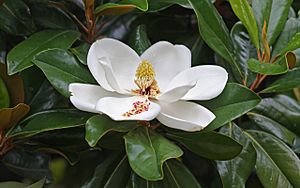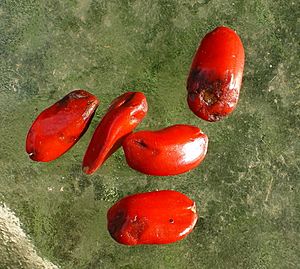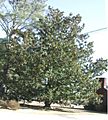Southern magnolia facts for kids
Quick facts for kids Southern magnolia |
|
|---|---|
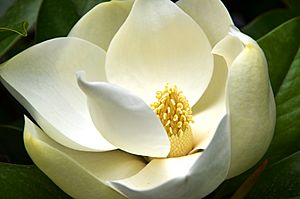 |
|
| Conservation status | |
| Scientific classification | |
| Genus: |
Magnolia
|
| Species: |
grandiflora
|
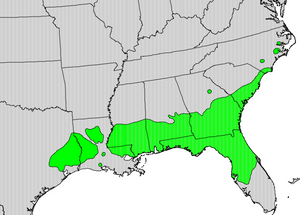 |
|
| Synonyms | |
|
|
The Magnolia grandiflora, often called the southern magnolia or bull bay, is a beautiful tree. It belongs to the Magnoliaceae family. This tree naturally grows in the southeastern United States. You can find it from Virginia down to central Florida, and west to East Texas.
Southern magnolias are large, impressive evergreen trees. They can grow up to 27.5 m (90 ft) tall. Their leaves are dark green and can be as long as 20 cm (7+3⁄4 in) and 12 cm (4+3⁄4 in) wide. The flowers are big, white, and smell wonderful. They can be up to 30 cm (12 in) across.
Even though it's from the warm, wet subtropical forests near the Gulf and Atlantic coasts, the southern magnolia is grown all over the world in places with warm weather. Its wood is strong and heavy. People use it to make things like furniture, wooden pallets, and thin wood layers called veneer.
Contents
What Does the Southern Magnolia Look Like?
The southern magnolia is an evergreen tree. This means it keeps its leaves all year long. It can grow very tall, sometimes up to 120 ft (37 m). Usually, it has one main trunk and grows in a pyramid shape.
Leaves and Flowers
The leaves are simple and oval-shaped. They are about 12–20 cm (4+3⁄4–7+3⁄4 in) long and 6–12 cm (2+1⁄4–4+3⁄4 in) wide. They have smooth edges and are dark green, stiff, and feel like leather. The underside of the leaves often has a fuzzy, yellow-brown coating.
The flowers are very noticeable and beautiful. They are white and smell like lemon and citronella. Each flower can be up to 30 cm (11+3⁄4 in) wide. They have six to 12 waxy petals. These flowers appear at the tips of branches on older trees in late spring.
Fruit and Seeds
After the flowers bloom, a rose-colored fruit appears. It's an oval-shaped polyfollicle. This fruit is about 7.5–10 cm (3–3+7⁄8 in) long and 3–5 cm (1+1⁄4–2 in) wide.
Record-Breaking Trees
Some southern magnolia trees have grown to amazing sizes in the southern United States. The tallest known tree is in Smith County, Mississippi. It stands 37 m (121 ft) tall! Another large tree in De Soto National Forest in Mississippi was 35 m (115 ft) tall in 1961. It had a trunk that was over 17 feet around.
How the Southern Magnolia Got Its Name
The famous scientist Carl Linnaeus first described the Magnolia grandiflora in 1759. He wrote about it in his book Systema Naturae. The name grandiflora comes from Latin words: grandis means "big," and flor- means "flower." So, it means "big flower." The name Magnolia was chosen to honor a French botanist named Pierre Magnol.
The most common name, southern magnolia, comes from where it grows in the Southern United States. People also call it "bull bay" because it's so big, or because cattle sometimes eat its leaves. Other names include laurel magnolia, evergreen magnolia, and big laurel. When its wood is used, it's simply called magnolia.
Where Southern Magnolias Grow
Southern magnolias are native to the southeastern United States. They grow from Virginia down to central Florida, and west to East Texas. You can often find them near water, like swamps, or in forests with other trees such as sweetgum, water oak, and black tupelo.
In protected areas, they grow into large trees. But on windy coastal dunes, they might stay as low shrubs. These trees don't do well with summer fires, so you won't find them in places that burn often.
Preferred Growing Conditions
In Florida, southern magnolias like shady spots with soil that drains well. They are found in high ground areas called hummocks, along ravines, on slopes, and in wooded floodplains. Even though they like moisture, they don't like to be flooded. They can also grow on sandy hills in coastal forests with live oaks and saw palmetto.
Sometimes, southern magnolias have spread beyond their original home. In the eastern United States, they have started growing naturally in the tidewater area of Virginia and other places.
Life Cycle of the Southern Magnolia
Southern magnolias can start making seeds when they are about 10 years old. However, they produce the most seeds when they are around 25 years old. About half of their seeds can sprout and grow into new trees. Birds and mammals help spread these seeds. Animals like squirrels, opossums, quail, and turkeys are known to eat the seeds.
How People Use and Grow Southern Magnolias
The southern magnolia was first brought to Britain in 1726 by a plant collector named Mark Catesby. It quickly became popular there. The French also collected it near the Mississippi River in Louisiana. People loved its beauty and fragrance.
Growing Southern Magnolias in the United States
The southern magnolia is a very popular tree to plant in gardens and parks. People love its shiny green leaves and sweet-smelling flowers. It has a long history in the southern United States. You can see many old, huge southern magnolias in cities like Houston, New Orleans, Mobile, Alabama, Jacksonville, Savannah, Charleston, and Wilmington.
This tree is so important that it is the state tree of Mississippi and the state flower of Louisiana.
Southern magnolias can grow quite far north. You can find them in coastal areas of New Jersey, Connecticut, Long Island, NY, and Delaware. They also grow in much of the Chesapeake Bay region in Maryland and eastern Virginia. On the West Coast, they can even grow as far north as Vancouver, Canada. However, the cooler summers there make them grow slower.
In the middle of the US, some types of southern magnolias that can handle cold weather grow well in northern Kentucky and Cincinnati, Ohio.
The White House Magnolia
For almost 200 years, a famous southern magnolia tree grew near the White House. President Andrew Jackson reportedly planted it from a seedling from his home in Tennessee. It was the oldest tree on the White House grounds. It was so well-known that it was even shown on the back of the $20 bill for many years.
People used to give cuttings or seedlings from this tree as gifts. For example, Ronald Reagan gave a cutting to his Chief of Staff. Michelle Obama also donated a seedling to a garden at the U.S. Department of Agriculture.
Since the 1940s, the tree needed support from metal poles and cables because part of its trunk had rotted. In 2017, experts decided to remove the tree because it was very fragile.
Growing Conditions and Care
Southern magnolias are good for planting near the seashore. They can handle windy conditions, but not too much salt spray. In very cold winters, especially in northern areas, their leaves might turn bronze, get spots, or burn if they are in full sun. However, most leaves stay on until new ones grow in spring.
Once they are established, these trees can handle dry periods well. They are actually the most drought-tolerant type of magnolia.
The leaves are heavy and fall off all year round. They create a thick layer on the ground. People also use the leaves in decorative flower arrangements. The waxy coating on the leaves helps protect them from salt and air pollution.
Uses of Magnolia Wood
In the United States, southern magnolia wood is harvested for commercial use. Along with sweetbay and cucumbertree, its wood is simply called magnolia. This wood is used to make furniture, boxes, pallets, window blinds, and doors. It's also used as veneer.
Southern magnolia wood has yellowish-white outer wood and light to dark brown inner wood, sometimes with yellow or green tints. The wood usually has a straight grain and an even texture. It is considered moderately heavy, hard, and stiff. It has moderate strength for bending and compression, and good resistance to shock. However, in the southeastern United States, harder woods are now often used instead.
Popular Types of Southern Magnolias
Over 150 different types, or cultivars, of southern magnolias have been created. About 30 to 40 of these still exist today. Most trees sold in nurseries are grown from cuttings. This helps them have a more consistent shape. Many older types have been replaced by newer ones.
Some types are known to be more resistant to cold weather:
- Bracken's Brown Beauty was created in the 1960s. It's a popular type that can survive cold winters in West Virginia, New Jersey, and Long Island, NY. It grows in a thick, compact shape with shiny, medium-sized leaves. Its flowers are about 5–6 in (13–15 cm) wide.
- Edith Bogue was brought to New Jersey from Florida in the 1920s. This type helped establish cold-hardy magnolias in the Middle Atlantic states. Once it's settled, 'Edith Bogue' leaves only get minor spots or burns in temperatures as low as −5 °F (−21 °C). It grows in a strong pyramid shape, reaching 35 ft (11 m) tall and 15 ft (4.6 m) wide. Its leaves are large and deep green, but they don't have the brown fuzz underneath that other types do.
- Angustifolia was developed in France in 1825. As its name suggests, it has narrow, spear-shaped leaves, about 20 cm (7.9 in) long and 11 cm (4.3 in) wide.
- Exmouth was developed in the early 1700s. It's known for its huge flowers, which can have up to 20 petals, and its strong growth. It often grows upright and is sometimes planted against walls. Its leaves are green on top and brownish underneath. The flowers smell very nice, and the leaves are narrow and leathery.
- Goliath has a bushier shape and round flowers up to 30 cm (12 in) wide. It flowers for a long time and has oval leaves without the brownish hair underneath.
- Little Gem is a smaller type. It grows well in warmer areas, from New Jersey southward. It grows slower and has a column shape, reaching about 4.25 m (13.9 ft) tall and 1.2 m (3.9 ft) wide. It flowers a lot in warm climates and has medium-sized, cup-shaped flowers. Its leaves are about 12.5 cm (4.9 in) long and 5 cm (2.0 in) wide. It flowers quite quickly after being planted.
- Victoria is a type grown in the Pacific Northwest. It is said to be able to handle temperatures down to -12°F. It has a more open shape and shiny dark green leaves with brown undersides.
Other common types include:
- Ferruginea has dark-green leaves with rust-brown undersides.
- Southern Charm is a smaller type that grows into a bushy shrub with a pyramid shape. It can reach 20–25 ft (6.1–7.6 m) tall and 10 ft (3.0 m) wide. It has dark green, shiny leaves that are 3–6 in (7.6–15.2 cm) long and 2–4 in (5.1–10.2 cm) wide, with brown undersides. It's also known as 'Teddy Bear' because of the fuzzy brown underside of its leaves.
Chemistry of the Southern Magnolia
The southern magnolia contains special natural chemicals. These chemicals have been shown to fight against certain bacteria and fungi. For example, substances like magnolol and honokiol are good at fighting some types of bacteria and fungi. The leaves also contain other chemicals called coumarins and sesquiterpene lactones.
Gallery
-
A large southern magnolia tree in Hemingway, South Carolina.
See also
 In Spanish: Magnolia grandiflora para niños
In Spanish: Magnolia grandiflora para niños



